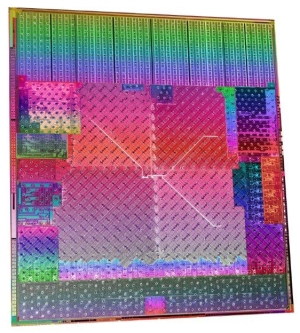AMD demo puts Zacate chip through its paces

AMD has stolen a little of Intel's thunder at the Intel Developer Forum by revealing advance details of two dual-core Bobcat CPUs in its Fusion line for notebooks and netbooks.
The chips, which AMD plans to ship in volume at the end of this year, are code-named Zacate and Ontario. On Tuesday, the company staged a demonstration of the Fusion chips, pitting the Zacate against Intel's Core i5. The chips will go up against Intel's Atom and Core models.
Zacate is an 18W chip designed for mainstream notebooks and desktop PCs, while Ontario is a 9W version for netbooks and other low-power systems. However, AMD is not aiming Ontario at tablet PCs, which the company believes should have a processor taking only 5W.

Zacate is an 18W chip designed for mainstream notebooks and desktop PCs. Photo credit: AMD
Both Zacate and Ontario have a DirectX 11-capable graphics processor that performs at the level of a discrete graphics chip, but is included on the same die as the two Bobcat CPU cores. AMD calls the combination an 'APU', or advanced processing unit. By comparison, Intel's upcoming Sandy Bridge chip will not support DirectX 11, Microsoft's latest collection of common application programming interfaces for visual applications.
Combining the CPU and GPU on the same die "gives mainstream performance in half of the area and at a fraction of the power", said AMD's Fusion product marking director Bob Grim. "We're bringing DirectX 11 to the market in a way that's so affordable that we think it's going to maintain pressure [on Intel]".
With a discrete graphics chip, "memory access has to go across the bus to the Northbridge, it's very indirect and takes a long time. This is a discrete-class graphics engine with the same access to memory that integrated graphics offers", Grim explained.
A premium four-core APU code-named 'Llano' will follow Zacate and Ontario in the first half of 2011, according to AMD. Llano also has a discrete-level DirectX 11 GPU that upconverts online video to close to 1080p HD resolution, the company said.
Zacate has a high-speed bus between the array of SIMD (single instruction, multiple data) engines that process media-handling commands and the x86 cores that reduces bottlenecks. It supports both low-power DDR3 memory and 1333MHz high-speed DDR3, neither of which Intel Atom processors currently support.
In addition, systems based on the Zacate CPU will have over 10 hours of battery life, as measured by the MobileMark benchmark, Grim said.
AMD showed a prototype of the Zacate chip running in a notebook platform, which Grim said represented a laptop that would sell for around $500 (£320). He compared the Zacate-based machine with an $800 Intel Core i5 system, and the 40 frames per second (fps) performance the Zacate system delivered in test running a 3D City of Heroes game was nearly twice what the Core i5 notebook managed.
The difference in performance was more marked in tests from Microsoft's Internet Explorer 9 (IE9) Platform Preview test site, showing the HTML 5 acceleration delivered by the GPU in Zacate. The Amazon Shelf test on the IE9 site, which indicates how the performance of the CPU-intensive canvas tag is improved by GPU hardware acceleration, was significantly faster and more fluid on the Zacate system, with again twice the frame rate.
The score on the Psychedelic Browsing IE9 test, which tests pure rendering speed as accelerated by the GPU, was significantly high. The score for the Zacate system was 1774, a figure similar to those attained by a desktop PC with a discrete ATI graphics card, compared with 177 from the integrated graphics of the Core i5 notebook.
As well as offering hardware acceleration for browsers such as IE9 and Firefox 4, which are written to use the GPU specifically, the Bobcat CPUs support DirectCompute and OpenCL 1.1 GP/GPU standards. These standards are used by tools such as Photoshop CS5 to speed up complex mathematical calculations for image editing.